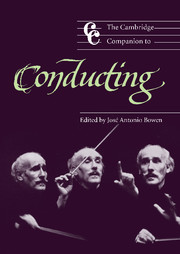8 - The rise of conducting
from Part II - History
Published online by Cambridge University Press: 28 September 2011
Summary
The history of conducting is hardly a linear progression of technical watersheds. The modern practice of conducting emerges slowly over several generations, but through a variety of different practices in different countries, genres and venues. During the first half of the nineteenth century, audible time-beating, different forms of divided leadership, and violin-bow direction all continue, with experiments in where to stand, which way to face, what to hold and generally what to do to bring order as larger ensembles struggle to play increasingly complex music.
To complicate things further, the rise of conducting happens while other aspects of European music-making are changing. The eighteenth-century musician may not have had a high place in society, but it was a clear place. The Kapellmeister was either a civil or high-level private servant charged with providing musical events from start to finish. This would generally include composing, copying, rehearsing, and performing the music. Musicians “wrote” music largely as notes for their own performances. Then technological changes made cheap music printing and mass-produced pianos possible. Political and economic changes ended the wealth of many royal patrons, who disbanded their orchestras and “freed” the musicians, creating a new middle-class market for their services. While musicians tried to piece together a living from teaching, composing, and performing (in both private and the new public concerts), music-making fragmented. The ability to purchase a piece of music on paper (instead of hiring musicians to perform) was a profound shift.
- Type
- Chapter
- Information
- The Cambridge Companion to Conducting , pp. 91 - 113Publisher: Cambridge University PressPrint publication year: 2003
- 3
- Cited by



